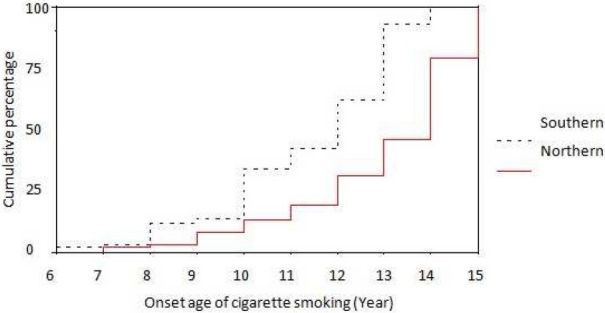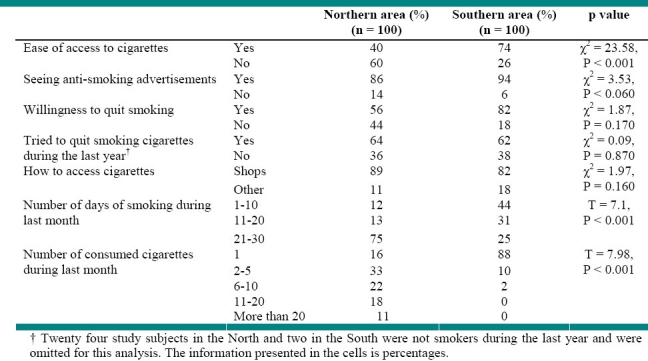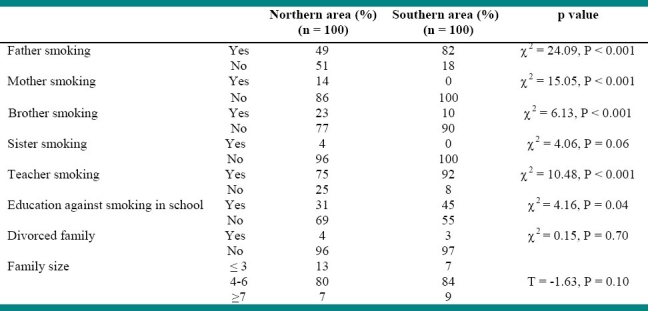Abstract
Objectives:
One of the main strategies to prevent smoking is delaying onset of smoking in adolescents. Thus, identifying the age of smoking and smoking pattern in adolescents gives important knowledge for planning the intervention programs on smoking.
Methods:
Students aged 13-15 years old living in the Northern and the Southern Tehran were selected through two separate snowball samplings. In each area six smokers were considered as the seeds and were asked to introduce a smoker friend. The sampling continued until one hundred study subjects were recruited in each area.
Results:
Although in the area with wealthier socioeconomic status the age at which smoking started was one year more, the number of days of smoking, number of consumed cigarettes, not willingness to quit smoking, ease of access to cigarettes, mother and siblings smoking were more frequent. In contrast, seeing anti-smoking advertisements, father smoking, teachers smoking and education about the adverse effects of smoking were lower than the area with poorer socioeconomic status.
Conclusions:
The community level interventions such as not selling cigarettes to juniors, quit smoking help and support, and education of families must be revised. The role of families, through the supervision and control over their children, and parents’ avoidance of smoking should be emphasized.
Keywords: Cigarette smoking, Socioeconomic status, Urban disparity, Iran
INTRODUCTION
Tobacco consumption is the major preventable cause of premature mortality and morbidity in the world. Approximately 5.4 million people every year die due to tobacco related diseases. If this trend does not change, this figure will be over 8 million in 2030. Vast majority of these deaths occur in developing countries.1 Tobacco consumption was responsible for 4.83 million premature deaths worldwide in 2002, of which 2.41 and 3.83 millions occurred in developing countries and among males, respectively.2
Although smoking rates have declined in adults,3 it is still high in adolescents and young adults.4 Twenty-five percent of teens who smoke daily will be dependent on nicotine in their adulthood.5 Smoking in adolescents is a problem that also has an impact on physical growth.6 The age at which adolescents start smoking will affect their health in older ages. Early onset of smoking during elementary school ages increases the chance of adulthood smoking.7 Those started smoking at 16 years of age or less are two times more at risk of never quitting smoking in comparison with those who start later than this age.8 In addition, nicotine addiction is more sever among those who start smoking earlier.9 The age of smoking onset has an inverse relationship with the number of days that a person smokes and the number of cigarettes consumed.10 Teens who smoke are more likely to be involved in illegal drugs and alcohol consumption, and deviant behaviors.11 Global statistics shows that tobacco use among students aged 13-15 is more than 10%. In addition, nearly one of every four smoker-student starts cigarette before age 10.12
A study showed that 29% of high school students in Tehran are occasional smokers.13 The prevalence of at least one smoking experience in Shiraz in the similar age group was 25.4%.14 Other studies in Iran revealed that the other family members smoking influences adolescents smoking.10,15,16 A qualitative study was conducted by the present article authors on factors affecting cigarette smoking in male adolescents in Tehran.17 The present study was following the preceded qualitative study to quantify the previous identified factors. The question was whether in two areas of Tehran, with inequality in socioeconomic status, the onset age and pattern of smoking in adolescents are different.
METHODS
The present article is the case wing of a case-control study assessing the factors affecting smoking. The former study about determinants of adolescents smoking was published elsewhere.18 One hundred male students aged 13-15 living in the Northern Tehran and a similar number in a Southern district were selected through snowball sampling.
The 1st and 17th districts respectively in the Northern and Southern Tehran were chosen for the purpose of sampling in this study. Housing, educational, sport and park spaces per capita can show diversity of economic status between two districts. While in the 1st district people have 55.1, 1.6, 0.6, and 5.3 square meters of these spaces, respectively, inhabitants in the 17th district have 11.6, 0.5, 0.2, and 1.3 square meters of similar indices.19
Snowball sampling is used for selection of individuals from hidden populations such as illegal drug users.20 The study in each district started with six teenagers as the seeds. Each was asked to name one of his friends who was a smoker (who smoked cigarettes regularly or occasionally for fun during last month).
The study continued with the newly (secondary) subject who was introduced by the former (index) subject. If the second person was not willing to answer, the index person was asked again to introduce another friend and in case he failed to introduce a new case, the inquiry stopped.
The only exclusion criterion from the study was communication problems.
The questionnaire included data on demographics, family, school status and smoking behavior. Content and face validity of the questionnaire were judged by three content experts. Reliability of the questionnaire was assessed by a test-retest study on 20 individuals within two weeks and the result, an intracluster correlation coefficient of 0.79, as was mentioned in the parallel paper of this study, was acceptable.18 Chi-square test for qualitative variables and student-t tests for quantitative variables were performed.
This study was reviewed and approved by the Ethic Committee of Tehran University of Medical Sciences. Questionnaires were filled without participant's names. Informed consents were obtained from the subjects before the study.
RESULTS
Since the sample size in both the Northern and Southern districts was one hundred, numbers in the result tables show not only frequency of observations but also their percentages.
Figure 1, by length of vertical lines, shows that the highest percentage of smoking onset was at ages of 14 and 13 in the Northern and Southern parts of Tehran with 33 and 31 percents, respectively.
Figure 1.

Cumulative frequency of age of smoking onset in male adolescents in the Northern and Southern districts of Tehran.
The minimum onset age for smoking was seven in the North and six in the South. Cigarette smoking started earlier in the Southern district compared to the Northern one, mean and standard deviation were 11.38 ± 1.92 in the South and 13 ± 1.94 in the North. This difference was statistically significant (P < 0.001).
Table 1 shows the pattern of smoking in the North and South of Tehran. In addition to the information given, it is good to know that the mean number of smoked cigarettes was eight times more in the North compared to the South (10.52 vs. 1.28 cigarettes).
Table 1.
Comparison of variables defining pattern of smoking in 13-15 year old smokers in the North and South of Tehran

Table 2 illustrates the status of families and the demographic indicators according to the districts. It should be noted that the mean and standard deviation of family size in the North and South were 4.67 ± 1.45 and 5.0 ± 1.41, respectively, and were not significantly different (P = 0.10).
Table 2.
Comparison of predisposing factors on cigarette smoking of adolescents in 13-15 year old smokers in North and South of Tehran

DISCUSSION
This study showed differences between higher and lower socioeconomic districts of Tehran regarding the age of smoking onset, access to cigarettes, the number of smoking days in the last month, number of cigarettes consumed in the last month, existence of smoker(s) in family and school education.
Several studies reported the pattern of smoking by adolescents, but to our knowledge there is no study which examines the pattern of smoking in the two areas with socioeconomic inequalities. The main limitation of this study could be the sampling method. Although snowball sampling improves participation of study subjects, all target population has not the same chance of participation in the study. Those who have more friends are more probable to be recruited in the study. If this characteristic, i.e. extraversion, influences distribution of the study variables, it could be a source of selection bias. On the one hand, there is no evidence regarding relationship of extraversion and the studied factors. On the other hand, snowball sampling is suitable to access to this study subjects. Since smoking in 13-15 year old adolescents is not socially desirable, the snowball sampling was selected.
Figure 1 shows the minimum age of smoking onset which was seven and six years in the North and South of Tehran. A study in Greece reported that 25.5% of boys started smoking when they were less than 10 years old.21 Because 13 and 34 % of students in the Northern and Southern districts started smoking in less than 10 years old, training on the hazards of smoking during elementary school is seriously recommended.
Table 1 shows the significant differences between the Northern and Southern districts on access to cigarettes, smoking days and the number of cigarettes consumed in the last month. Therefore, cigarette smoking in the Northern district with higher socioeconomic status is more serious and the adolescents not only smoke more but also find cigarettes easier, despite the fact that cigarette smoking starts earlier in the Southern district in comparison with the Northern one.
The majority of subjects purchased cigarettes from the stores which means cigarettes are easy to access. Studies in Turkey22 and Thailand23 reported that 48.5% and 36.9% of smoker boys, respectively, bought cigarettes from the stores. Significant difference was shown between two districts regarding not selling cigarettes to adolescents. Report on two times more non-refusal for in purchasing cigarettes in Southern part shows relative ease of access to cigarettes in the North and failure of this community level intervention at least in the Northern Tehran. This figure was reported to be 94.7% in Greece21 and 36.9% in Thailand.23
Around 90% of the study subjects in both areas expressed that they have seen anti-smoking advertisements, but unfortunately, these advertisements had no effect on them. The study in Greece similarly showed the corresponding figure as 89.9%. It is important to know that proportion of those who smoked cigarettes for 21-30 days in the last month was three times more in the Northern than the Southern district. In addition, percentage of those who smoked more than 10 cigarettes per day in the North was 29 vs. zero in the South. Eighty eight percent of smokers in the South smoked just one cigarette per day, while this was 16% in the north. None of study subjects in the Southern district reported consumption of more than 10 cigarettes per day. Therefore, the adolescents in wealthier part of the city smoked heavier.
Table 2 shows that smoking of mothers, fathers, teachers and brothers were statistically different in the two districts. Just smoking of sisters was less common and subsequently did not differ between the two groups. Previous studies showed a relationship between smoking of teenagers and their parents.24 In addition, different studies reported similar association of adolescents smoking and having more than one smoker among family members.10,13,15,16 Since not having smoker family members is a well recognized factor, families’ education and preparing a non-smoking environment in the families might be an effective intervention. Association of teachers smoking is also well known.25 More than half of the subjects in both areas never had training against smoking. Given the importance of teenagers’ education on awareness and subsequent behaviors, conducting well prepared trainings is recommended.
CONCLUSION
The onset age of smoking, how to access and ease of access to cigarettes, willingness to quit smoking, number of days which individuals smoke, number of cigarettes consumed per day, presence of smokers in those around and school education were different in the Northern and Southern Tehran. It seems the existing prevention programs, especially not selling cigarettes to juniors, supporting and helping smokers to quit smoking and family education, should be revised in Tehran.
Footnotes
Conflict of interest statement: All authors declare that they have no conflict of interest.
Source of funding: This study was supported by Tehran University of Medical Sciences with the grant number 5749.
REFERENCES
- 1.Centers for Disease Control and Prevention. Global Tobacco Control. [Online] [Cited 2011 March 30]. Available from: URL: http://www.cdc.gov/tobacco/global/index.htm .
- 2.Ezzati M, Lopez AD. Estimates of global mortality attributable to smoking in 2000. Lancet. 2003;362(9387):847–52. doi: 10.1016/S0140-6736(03)14338-3. [DOI] [PubMed] [Google Scholar]
- 3.Levy DT, Nikolayev L, Mumford E. Recent trends in smoking and the role of public policies: results from the SimSmoke tobacco control policy simulation model. Addiction. 2005;100(10):1526–36. doi: 10.1111/j.1360-0443.2005.01205.x. [DOI] [PubMed] [Google Scholar]
- 4.Lantz P. Smoking on the rise among young adults: implications for research and policy. Tob Control. 2003;12(Suppl 1):i60–i70. doi: 10.1136/tc.12.suppl_1.i60. [DOI] [PMC free article] [PubMed] [Google Scholar]
- 5.Patton GC, Coffey C, Carlin JB, Sawyer SM, Wakefield M. Teen smokers reach their mid twenties. J Adolescent Health. 2006;39(2):214–20. doi: 10.1016/j.jadohealth.2005.11.027. [DOI] [PubMed] [Google Scholar]
- 6.Stice E, Martinez EE. Cigarette smoking prospectively predicts retarded physical growth among female adolescents. J Adolescent Health. 2005;37(5):363–70. doi: 10.1016/j.jadohealth.2004.10.017. [DOI] [PubMed] [Google Scholar]
- 7.Chassin L, Presson C, Sherman SJ, Edwards DA. The natural history of cigarette smoking: predicting young-adult smoking outcomes from adolescent smoking patterns. Health Psychol. 1990;9(6):701–16. doi: 10.1037//0278-6133.9.6.701. [DOI] [PubMed] [Google Scholar]
- 8.Khuder SA, Dayal HH, Mutgi AB. Age at smoking onset and its effect on smoking cessation. Addict Behav. 1999;24(5):673–7. doi: 10.1016/s0306-4603(98)00113-0. [DOI] [PubMed] [Google Scholar]
- 9.Washington, DC: U.S. Department of Health and Human Services; 1994. U.S. Department of Health and Human Services. Preventing Tobacco Use Among Young People: A Report of the Surgeon General. [Google Scholar]
- 10.Kelishadi R, Ardalan G, Gheiratmand R, Majdzadeh R, Delavari A, Heshmat R, et al. Smoking behavior and its influencing factors in a national-representative sample of Iranian adolescents: CASPIAN study. Prev Med. 2006;42(6):423–6. doi: 10.1016/j.ypmed.2006.03.001. [DOI] [PubMed] [Google Scholar]
- 11.Newcomb MD, Maddahian E, Bentler PM. Risk factors for drug use among adolescents: concurrent and longitudinal analyses. Am J Public Health. 1986;76(5):525–31. doi: 10.2105/ajph.76.5.525. [DOI] [PMC free article] [PubMed] [Google Scholar]
- 12.World Health Organization. Tobacco Free Initiative (TFI). About youth and tobacco. [Online] [Cited 2011 April 5]. Available from: URL: http://www.who.int/tobacco/research/youth/about/en/index.html .
- 13.Heydari G, Sharafi H, Hosseini M, Masjedi MR. Prevalence of smoking among high school students of Tehran in 2003. East Mediterr Health J. 2007;13(5):1017–21. doi: 10.26719/2007.13.5.1017. [DOI] [PubMed] [Google Scholar]
- 14.Ahmadi J, Hasani M. Prevalence of substance use among Iranian high school students. Addict Behav. 2003;28(2):375–9. doi: 10.1016/s0306-4603(01)00246-5. [DOI] [PubMed] [Google Scholar]
- 15.Kelishadi R, Mokhtari MR, Tavasoli AA, Alireza Khosravi, Ahangar-Nazari I, Sabet B, et al. Determinants of tobacco use among youths in Isfahan, Iran. Int J Public Health. 2007;52(3):173–9. doi: 10.1007/s00038-007-6017-x. [DOI] [PubMed] [Google Scholar]
- 16.Ayatollahi SA, Mohammadpoorasl A, Rajaeifard A. Predicting the stages of smoking acquisition in the male students of Shiraz's high schools, 2003. Nicotine Tob Res. 2005;7(6):845–51. doi: 10.1080/14622200500330233. [DOI] [PubMed] [Google Scholar]
- 17.Rezaei F, Majdzadeh R, Nedjat S, Golestan B. Motive for cigarette smoking in 13-to 15-year-old boys A qualitative study. Journal of School of Public Health and Institute of Public Health Research. 2007;5(4):25–33. [Google Scholar]
- 18.Rezaei F, Nedjat S, Golestan B, Majdzadeh R. Reasons for smoking among male teenagers in Tehran: Two case control studies using snowball sampling. International Journal of Preventive Medicine. (In Press) [PMC free article] [PubMed] [Google Scholar]
- 19.Hadipor HK, Farhoodi R, Porahmad A. Efficient Criteria for Delimitation of Urban Regions, A case study: Region No.1 of Tehran Municipality. Geographical Research. 2006;38(57):93–111. [Google Scholar]
- 20.Last JM. 3rd ed. New York: Oxford University press; 1995. A dictionary of epidemiology. [Google Scholar]
- 21.Kyrlesi A, Soteriades E, Warren CW, Kremastinou J, Papastergiou P, Jones NR, et al. Tobacco use among students aged 13–15 years in Greece: the GYTS project. BMC Public Health. 2007;7:3. doi: 10.1186/1471-2458-7-3. [DOI] [PMC free article] [PubMed] [Google Scholar]
- 22.Erguder T, Çakir B, Aslan D, Warren CW, Jones NR, Asma S. Evaluation of the use of Global Youth Tobacco Survey (GYTS) data for developing evidence-based tobacco control policies in Turkey. BMC Public Health. 2008;8(Suppl 1):S4. doi: 10.1186/1471-2458-8-S1-S4. [DOI] [PMC free article] [PubMed] [Google Scholar]
- 23.Sirichotiratana N, Techatraisakdi C, Rahman K, Warren CW, Jones NR, Asma S, et al. Prevalence of smoking and other smoking-related behaviors reported by the Global Youth Tobacco Survey (GYTS) in Thailand. BMC Public Health. 2008;8(Suppl 1):S3. doi: 10.1186/1471-2458-8-S1-S3. [DOI] [PMC free article] [PubMed] [Google Scholar]
- 24.Tercyak KP, Lerman C, Audrain J. Association of attention-deficit/hyperactivity disorder symptoms with levels of cigarette smoking in a community sample of adolescents. J Am Acad Child Psychiatry. 2002;41(7):799–805. doi: 10.1097/00004583-200207000-00011. [DOI] [PubMed] [Google Scholar]
- 25.Sreeramareddy CT, Kishore PV, Jagadish Paudel JP, Menezes RG. Prevalence and correlates of tobacco use amongst junior collegiate in twin cities of western Nepal: A cross-sectional, questionnaire-based survey. BMC Public Health. 2008;8:97. doi: 10.1186/1471-2458-8-97. [DOI] [PMC free article] [PubMed] [Google Scholar]


